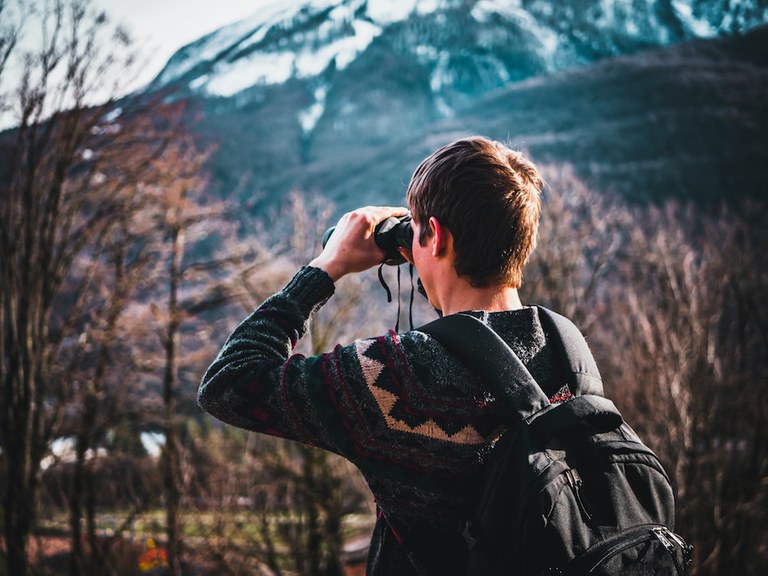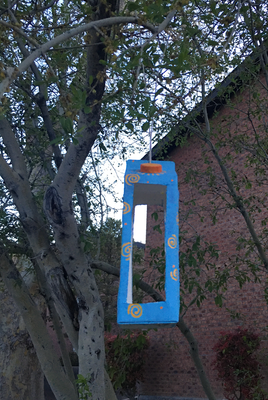Citizen Science
Goal
Learn about the citizen science network and participate in actual scientific data collections.
You don’t have to be wearing a lab coat or safety goggles to be a scientist. You can contribute to the scientific community right from your own backyard! Today, we will discover the importance of citizen science, learn about what the ABQ BioPark does for our community, and investigate how you can partake and contribute to citizen science.
Introduction to Citizen Science

What are the qualities that make a good scientist? Think about the steps involved in the scientific method. The first step of the scientific method starts when you ask a question about something you’ve observed in the natural world. As you are out and about you can use your five sense to explore different things around you that can lead to questions. You might ask yourself, "Why are the bugs gathering together on the sidewalk?" Or perhaps, "Why are the clouds wispier today than they were yesterday?" After you have developed an observation, then it’s time to hit the books. Do a bit of background research to try to answer your question. Performing research enables you to understand the why’s and how’s of your observation, and it allows for better experimentation. Background research can include looking up information on reputable websites or books, talking to someone who has previous experience with your question, or even making more observations.
Step number two is to take your observation and turn it into a question with a hypothesis. A hypothesis is an educated guess that is written as an “if, then” statement. This is used to help predict what you think will happen during your experiment. For example, if you want to ask what happens if we mix vinegar and baking soda together, you would state it as “If I mix vinegar and baking soda together, then this will happen.” Your hypothesis will help you make a yes or no statement and focus your experiment on one area so you can gather accurate information. After your experiment is completed, you will know if the hypothesis is correct or not.
Once your hypothesis is set, you can begin to conduct an experiment. Often people think of experiments being conducted in a lab with test tubes, Bunsen burners and other equipment. Most experiments do not involve these materials at all, and for some, all you need is a notebook to write down observations. A good experiment is easy to replicate or for someone else to do. Every step that you take should be written down so that someone else can copy it or try it out. This is similar to how we share recipes; if you forgot to include flour in your cookie recipe, it could make the whole thing go awry.
Each experiment that you want to conduct should include variables. Variables are the factors that come into play that could affect the outcome of your experiment. What variables do you think you will encounter during your experiment?
After you have done your experiment, the last step of the scientific method is to think out about what your experiment meant for your hypothesis. Remember, your hypothesis is what you thought would happen during your experiment. At this point, your hypothesis is either accepted or rejected. Just because your hypothesis is rejected doesn’t mean you have conducted bad science. It is always wise to be honest about your findings and to share what you learned with others!
To get your start in science, you can try out these simple experiments from home:
- Go on a nature walk and gather things along the way. Then experiment to see if your collected items will sink to the bottom or have enough buoyancy to float in a bowl of water by doing the Sink or Float Experiment (Ages 3-6).
We are facing global challenges, so scientists are needed more than ever before. Scientists around the world are banding together in order to protect endangered species, safeguard our water sources and prevent diseases from spreading. You can make a huge impact in helping scientists by collaborating and sharing your observations as a citizen scientist. Citizen science is the practice, collection, collaboration and analysis of data relating to the natural world by members of the general public, typically as part of a collaborative project with professional scientists in order to increase scientific knowledge.
Citizen science bridges the gap of recorded observation by harnessing the power of people who are motivated by curiosity, a desire to advance research or a concern about environmental conditions in their communities. Citizen science enables participants to make a direct contribution to research, increase their scientific understanding and immerse themselves in learning about environmental issues.
ABQ BioPark and Citizen Science
At the ABQ BioPark we have formed the Conservation Committee that includes environmentally-minded staff from all of our facilities; the Zoo, Aquarium, Tingley Beach and Botanic Garden. The committee meets once a month to discuss conservation initiatives related to the ABQ BioPark such as education, operations, in-situ conservation, policy advocacy, community engagement and in-house conservation. The goal of the Conservation Committee is to inspire local and global conservation efforts by leading in sustainability, education, research and collaborative partnerships. As a citizen scientist, you could directly help the ABQ BioPark’s Conservation Committee’s mission by sharing your observations of the natural world that surrounds you.
Some of our projects that have been directly influenced by the aid of our incredible task force of trained volunteers include zoo monitoring. Currently, our zoo monitoring program includes observing a wide range of animals here at the ABQ BioPark. We use the data collected during observations to collaborate with other Zoos and Aquariums across the nation. The current list of animals being monitored include rhinoceros, Hartmann's mountain zebras, chimpanzees, giraffes, mountain lions, hyenas, gorillas, wolves, sea eagles and condors. In the future, we hope to have all ABQ BioPark animals receiving routine observations. Our volunteers devote countless hours towards behavioral observations that help our zookeepers keep a watchful eye on the animals from all angles. The goal of zoo monitoring is to monitor species-specific behavior and to see if species are reaching targeted appropriate behavior. How will your observations impact the world around you? How do you plan on sharing your discoveries with others?
Activity
Birdhouse Craft for kids
Materials
- Empty cartons, washed and dried
- Knife
- Acrylic paint
- Paint brush
- Water
- Paper towels
- Punch hole
- String or yarn
- Scissors
- Bird seed
Directions
- With parental guidance, use a knife to cut the sides out of an empty clean and dried carton.
- Place the carton on a protected surface and paint with acrylic paints. Get creative and design your birdhouse!
- After decorating, set it aside to let it dry.
- When it's completely dry, poke a hole into the top on each side of the carton with a hole punch.
- Thread a piece of yarn or string through the carton and knot at the top to hang.
- Fill with bird seed and find the perfect location. Observe the birds it attracts.
- Scientists often have field notebooks; think of it as a natural world diary. Create your own field notebook.
- Spend 15 minutes in your own backyard to help expand your understanding of birds.
- What variables can you control during your observations? For example, try to make your recorded observation times consistent. Maybe spend 15 minutes per hour observing your birdhouse.
- Take into consideration natural variables that might affect your recording each day. Natural variables can include but are not limited to: Was the weather nice or overcast? Was the bird feeder in the shade?
- Compare your observations to previous recordings. Do you notice a pattern or trends?
- Grab your binoculars and share your findings with fellow ornithologists (bird scientists) using eBird.
Additional Resources
There are thousands of global citizen science projects, find your topic interest at Project Finder.
